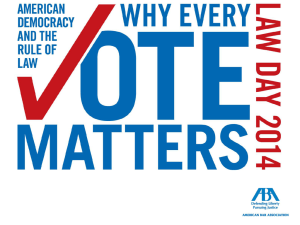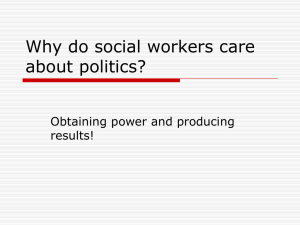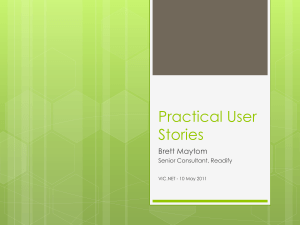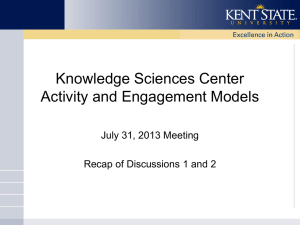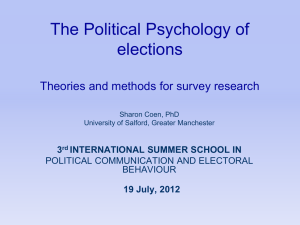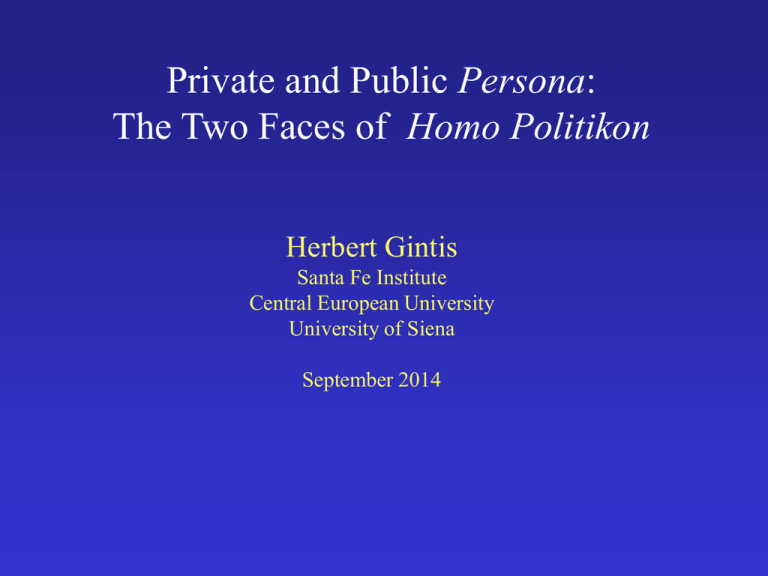
Private and Public Persona:
The Two Faces of Homo Politikon
Herbert Gintis
Santa Fe Institute
Central European University
University of Siena
September 2014
Collective Action
The struggle for democracy, from the nineteenth century
to the present, involved spontaneous collective action.
Virtually every addition to the repertoire of human rights
in the twentieth century and the present (e.g., civil
rights and feminist movements in USA, Arab spring in
Middle East) was the result of collective action not
rewarded by established incentive mechanisms.
Collective action is a public goods game in which the
contribution of each participant is so small that it does
not figure in the decision whether or not to participate.
Collective Action
The benefits of collective action accrue whether or not the
individual participates. We term such behavior noninstrumental or non-consequential.
The social goals of collective action are broader than each
participant’s personal self-interest. Participation in
collective action is thus other-regarding.
Because the personal costs of participation are positive
and benefits are non-consequential, participating is a
rather unique form of altruistic behavior.
The preferences of participants in collective action are
thus non-instrumental, other-regarding, and altruistic.
Voting
A salient form of collective action is voting in large-scale
elections.
Rational choice theorists have attempted, since Anthony
Downs (1957) and Mancur Olson (1965) to explain
voting as instrumental behavior.
This requires each voter to compare the personal cost c of
voting to the personal benefit b should his candidate
win the election times the probability p that he is the
pivotal voter whose participation turns defeat into
victory.
The self-regarding rational voter votes if p b > c and
abstains if the reverse inequality obtains.
Voting
However, p is infinitesimally small (no large election has
ever been determined by a single vote) while the cost c
is positive and possibly large.
Despite several prominent attempts, there is no model in
the literature explaining a high level of voter turnout in
all but the smallest groups assuming instrumental voters
with self-regarding preferences.
Instrumental Voting
Perhaps voters are instrumental but other-regarding,
weighting the gains to society as a whole if their
favored candidate wins the election.
With this assumption there are models for which it is
instrumentally rational to vote even in very large
elections.
These models are implausible because the benefit b must
be huge in a large election while many voters
participate even when they perceive only moderate
differences between the candidates other than personal
attractiveness (e.g., vote for a co-ethnic).
Moreover, when asked why they vote, respondents never
say that the small probability of making a difference is
offset by the huge social gain should this occur.
Instrumental Voting
An implausible aspect of such instrumental altruistic
models is that it assumes voters are strongly
paternalistic: voter A assumes that those who vote for
the other candidate are simply mistaken, and would be
better off if voter A’s candidate prevailed.
For if A is the pivotal voter then there are equal numbers
of voters on each side, and if A values their preferences
equally, then the total social benefit of A’s candidate
winning is simply A’s personal benefit, however
altruistic A might be.
Civic Duty Voting
Suppose voting is non-instrumental but a civic duty;
rational voters get an additional payoff d from voting.
Then it is rational to vote if b p + d > c, which is the same
as d > c, since p ≈ 0.
Many voters consider it a civic duty to vote, but this does
not explain why
• they vote for one candidate over another,
• they become politically informed,
• they become politically engaged and actually prefer to
vote, and
• they engage in strategic voting (voting for someone
other than their most preferred candidate).
Social Pressure Voting
Suppose voting is non-instrumental but one is rewarded
for voting by social network members for being a “good
citizen.” Then rational voters get an additional payoff d
from voting, so it is again rational to vote if d > c.
There are models that exhibit high voter turnout with such
an assumption.
But the assumption is questionable.
The main problem is that most people do not in fact base
their relations with social network members in any way
on the knowledge of the latters’ voting behavior.
This assumption also does not explain strategic voting,
politically committed voting, or the fact that voters care
about who they vote for.
Social Rationality
I will define Homo Politikon as a socially rational agent,
a concept stronger than Bayesian rational.
Bayesian rationality (Savage 1954) is incapable justifying
the choice of a Pareto-efficient Nash equilibrium in a
pure coordination game with a distinct Pareto-efficient
equilibrium.
U
D
U 1,1
0,0
D
0,0
0,0
For instance, consider the above. The Pareto-superior
(Up,Up) equilibrium cannot be justified by a Bayesian
rationality argument.
Social Rationality I
Let us say a strategy profile
in an nplayer game strictly dominates a strategy profile
if the payoff to is strictly greater
than the payoff to for each player i = 1,…,n.
Let us say that a strategy profile is socially irrational if
there is a strategy profile that strictly dominates .
Finally, let us say that agents are socially rational I if they
never play a socially irrational strategy profile.
The notion of social rationality cannot be expressed in
terms of individual rationality (Gintis, Bounds of
Reason 2009).
Social Rationality II
Bayesian rationality (Savage 1954) is incapable justifying
pre-play agreement on a Nash equilibrium.
For instance, consider the following game:
U
D
U
1,1
0,0
D
0,0
1,1
Bayesian rationality cannot justify a pre-play agreement to
both choose U.
Social Rationality II
We say a set of players is socially rational II if they play a
Nash equilibrium upon which they have agreed through
pre-play communication.
Homo Politikon:
Social Rationality III
The concept of Homo Socialis has been based on game
theory with other-regarding preferences, and assumes
consequentialist behavior.
Homo Politikon, the non-instrumental participant in
collective action, is a novel form of Homo Socialis
(Hamlin and Jennings 2011).
I propose that a social actor has a distinct preference
ordering for political behavior in collective action
contexts which represent his public persona.
The costs of participating are borne by the actor’s private
persona, but the benefits, being purely noninstrumental, accrue to his public persona.
Homo Politikon:
Social Rationality III
Homo Politikon = (private persona, public persona) is
social rationality III.
Private persona activities x are instrumental, represented
by a payoff function u(x), whereas public persona
activities y are non-instrumental with payoffs v(y).
The act of voting is a private persona cost, so it is a
component of x, and total payoff can be represented as
u(x) + α v(y),
where α is a constant given by the social situation.
Homo Politikon:
Social Rationality III
Homo Politikon maximizes
u(x) + α v(y),
over choice set X consisting of pairs (x,y),
where α depends on degree of political commitment and
awareness, the expected closeness of the election, the
expected turnout, and whether the agent’s preferred
candidate is expected to win or lose.
Homo Socialis and
Homo Politikon
Note that v(y) > 0 is not irrational.
Voting and other forms of collective action are in one
sense like clapping after a music concert or cheering for
a sports team (even when at home in front of the TV).
Clapping and cheering are expressive rather than
instrumental, but they lack a political and moral
dimension.
Behavioral models of expressive behavior have not, to my
knowledge, been developed.
Public persona political activity is both expressive and
political/moral: there is a (supererogatory) duty to act
politically.
Homo Politikon
What is the nature of the political preference function
v(y)?
See Hamlin and Jennings (British J Pol Sci 2011).
I conjecture that for most voters, the principle of ruleeffectivity explains behavior: choose a rule that likeminded voters might choose, and if followed by such
voters, would lead to the most desirable outcome.
This leads voters to act in very large elections in much the
same way they would in very small elections where
voting is in part instrumental
except that the instrumental u(x) and the noninstrumental v(y) can push in different directions.
Homo Politikon
Why, despite hundreds of papers on the free rider paradox
in voting and collective action, has no one proposed the
(rather obvious) public/private persona model?
The concept of a public persona conflicts with
methodological individualism. Other-regarding
preferences do not present this conflict. Empathy,
fairness, and strong reciprocity are all modeled simply
by adding arguments to the actor’s preference function
but retaining the assumption of instrumental action.
We do have a category of moral behavior that is not
instrumental: character virtues.
Character Virtues
Character virtues are behaviors valued for their own sake,
not for, and even despite, their personal or social
effects.
Honesty, courage, considerateness, helpfulness and
politeness are character virtues.
For instance, often one is honest not because one cares
about others and not because one fears punishment for
lying, but simply because it is the right thing to do.
For experimental evidence, see Gneezy AER (2005).
Evidence for a Public Persona
If you ask a voter at the polling center why they are there,
the common response is “I want to help candidate A
win the election.”
If you respond by noting that the chance of being the
pivotal voter is virtually zero, you might get the
response “But some important elections are decided by
just a few hundred votes.”
If you respond that one single vote still would not make a
difference, you might get the response “Well, if
everyone thought that way, democracy would collapse.”
If you respond that since everyone does not think that
way, your vote still doesn’t matter, you risk physical or
verbal assault.
Evidence for a Public Persona
Many citizens agree with the assertion “my single vote
won’t make a difference, but if all concerned citizens
vote our common concerns, we can make a difference.”
For homo politikon, statements such as “I am helping my
candidate win by voting,” and “I am helping promote
democracy by demonstrating against the dictator” are
literally correct in terms of social rationality III,
however illogical in pre-social rationality terms.
Evidence for a Rule-Effectivity
There is no way to express non-consequentialist rational
choice in common parlance.
When I tried to explain the paradox of voting to social
scientists forty years ago, even prominent psychologists
and anthropologists simply could not understand the
problem.
Indeed, when I attempt to explain this situation to a lay
audience, many listeners cannot understand how it is
not in their personal interest to vote.
In fact, with a public persona, political participation is a
self-interested, other-regarding, act.
Private and Public Persona
An often expressed paradox is that many voters vote their
self-interest, in the sense that they vote for the candidate
who, if successful, will implement policies favoring
themselves.
This behavior is inexplicable using an instrumental
rational choice model.
The paradox is that a voter who votes is altruistic. So why
would such a voter vote his self-interest?
The answer is that his public persona preference ordering
systematically favors his personal self-regarding
concerns.
Private and Public Persona
With dual private/public personas, we have a two-way
categorization of individual preferences:
Persona
Self-regarding
Other-regarding
Private
Homo Economicus
Homo Socialis
Public
Homo Parochialis
Homo Moralis
In this diagram, Homo Economicus is the self-regarding
(instrumental) private persona, Homo Socialis is the otherregarding (instrumental) private persona.
Homo Parochialis and Homo Moralis are the new actors on stage:
contrasting types of (non-instrumental) public persona.
Homo Parochialis
A voter is embedded in a variety of social networks,
among which one reflects his economic position in
society, another the common morality of others with
whom he is socially networked, and a third his
demographics (ethnicity, age, sex, geographic region,
and the like).
Homo Parochialis votes because he has a sufficiently
strong public persona, and being self-regarding (which
we term parochial), he votes for a balance of the
economic and moral interests of the particular social
networks to which he adheres.
Homo Moralis
Homo moralis is an other-regarding public persona, who
takes the well-being of society as a whole into account
in being motivated to vote, and in choosing his
preferred candidate.
For instance, Homo Moralis may make his choices under
John Rawls’ veil of ignorance, John Harsanyi’s
criterion of universality, or John Roemer’s Kantian
equilibrium.
The Evolution of the Public Persona
There is no evidence of a public persona in non-human
species.
We are indeed uniquely Homo Ludens (Man, the game
player), capable of constructing social games and
playing by the rules of these games.
A collective action is a coordinated attempt to change the
rules of the game of society.
Voting involves sophisticated game-playing cognition.
These human cognitive capacities evolved through geneculture coevolution.
The Evolution of the Public Persona
Humans evolved in small hunter-gatherer bands that
developed highly complex political relationships.
Political decision-making within these societies was
critical for the biological fitness of group members.
Homo Parochialis evolved because groups with many
politically sophisticated and committed members chose
their leaders wisely and hence outcompeted groups with
less effective mechanisms of determining group
leadership and organization.
The Evolution of the Public Persona
The following material is taken from my paper with
primatologist/anthropologists Carel van Schaik and
Christopher Boehm, under revise and resubmit at
Current Anthropology.
The paper can be downloaded from my website: The
Evolutionary Origins of Human Political Systems
The Evolution of the Public Persona
The most recent common ancestor of the great apes and
humans lived in multi-male/multi-female groups in
which social dominance was based on physical prowess
(the alpha-male).
Hunter-gatherers, the primitive social state of our species
until some 10,000 years ago, practiced “reverse
dominance hierarchy”
in which the primate predisposition to control through
hierarchical dominance was consciously and
successfully counteracted by widespread egalitarian
practices (Boehm, Hierarchy in the Forest, 2000).
Maintenance of control over leaders rendered political
sophistication broadly fitness-enhancing.
Ancestral Primate Social Structure
Multi-male/multi-female primate groups appeared some 52
million years ago (Shultz et al., Nature 2011).
Mating was promiscuous and males formed a hierarchical
power structure with a single alpha male at the apex.
In chimps, the alpha male sires 1/3 to 2/3 of offspring, but
maintains alpha position only for about four years.
Individuals know their mothers but not their fathers. There
is no pair-bonding in such societies.
All non-human primates who live in multi-male/multifemale groups exhibit this living pattern.
Primate Tools and their Usage
The emergence of lethal weapons in hominids (the human
ancestor line) shattered this form of social existence.
Apes are capable of tool use (e.g., harvesting termites with
a stick) and they throw stones in disputes or to chase a
predator.
However, they do not manufacture tools (e.g., sharpen
stones, fashion spears and poison arrows), or combine
disparate materials (e.g., stone and wood).
Moreover, because of knuckle-walking, their bodies are
not constructed to throw with accuracy or velocity.
As a result, they cannot kill by means of lethal weapons.
Demonic Males
A male chimpanzee is unharmed by surprise attack by a
single aggressor.
Richard Wrangham (1996) recounts several instances
where even three or four male chimpanzees viciously
and relentlessly attack a male for twenty minutes
without succeeding in killing him.
The weakness of chimpanzees in this regard is not simply
due to the lack of the appropriate lethal weapon,
but also the inability to wield effectively potentially
dangerous natural objects, for instance stones and rocks.
A chimpanzee may throw a rock in anger, but rarely will it
achieve its target.
Primate Social Power
The alpha male in non-human primate multi-male/multifemale groups is not a leader, but rather a surplus
extractor.
The dissolution of the alpha male hierarchy in hominids
became costly when hominid societies became highly
cooperative in scavenging and/or hunting,
and therefore required an efficient and incentive
compatible political structure.
Hominid Social Power
Given lethal weapons, hominid groups had to find some
basis for leadership other than force.
The solution was democratic and egalitarian political
structure in which leadership fell to those who had
superior coalitional and persuasive powers (see Chris
Boehm, Hierarchy in the Forest, 1999 and Moral
Origins: The Evolution of Virtue, Altruism, and Shame
2012).
The more skilled, the more talented, and the more
intelligent individuals held positions of high social
influence and even power in such new arrangements,
and since these positions could not be held by force,
they must have been held by persuasion.
Hominid Social Power
Thus successful hominid social bands came to value
individuals who could command prestige by virtue of
their persuasive capacities.
Hunter-gatherer life thus favored progressive cephalization
and the evolution of language.
In short, two million years of evolution in the presence of
lethal weapons gave rise to the particular physical,
moral, political and cognitive qualities of Homo sapiens.
Whence the emergence of Homo Politikon as a central
figure in the human repertoire.



